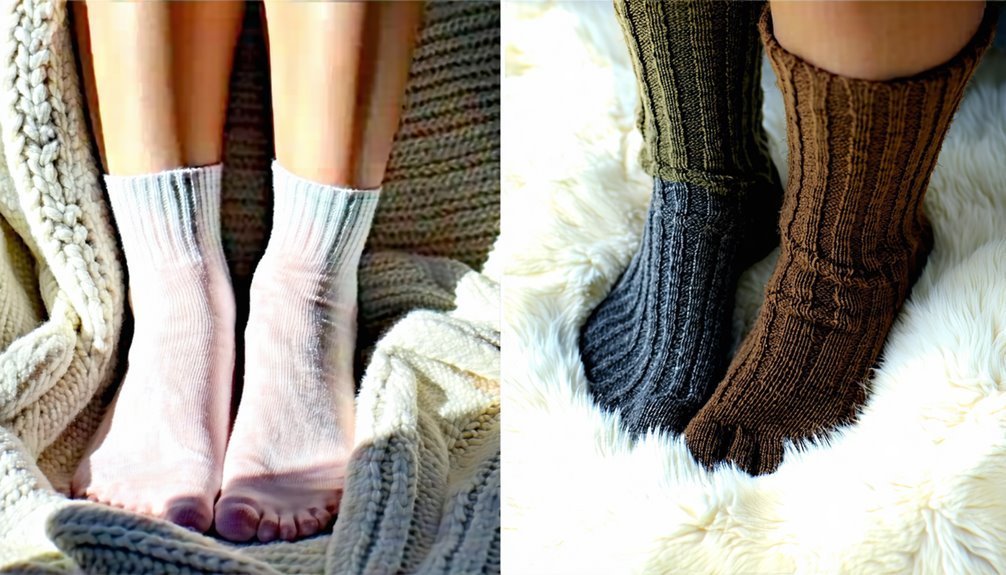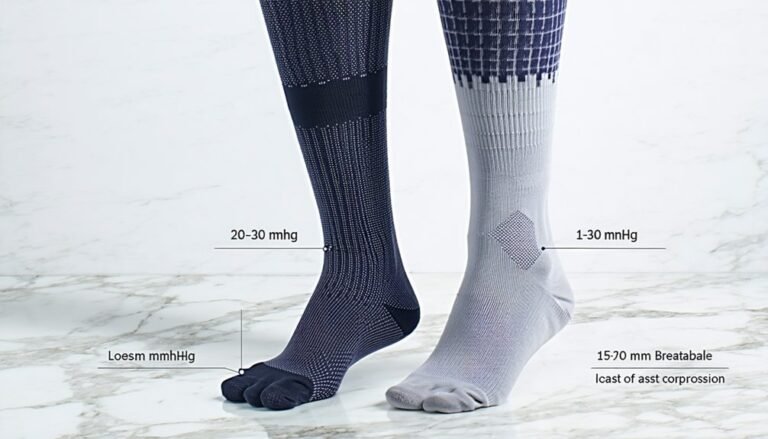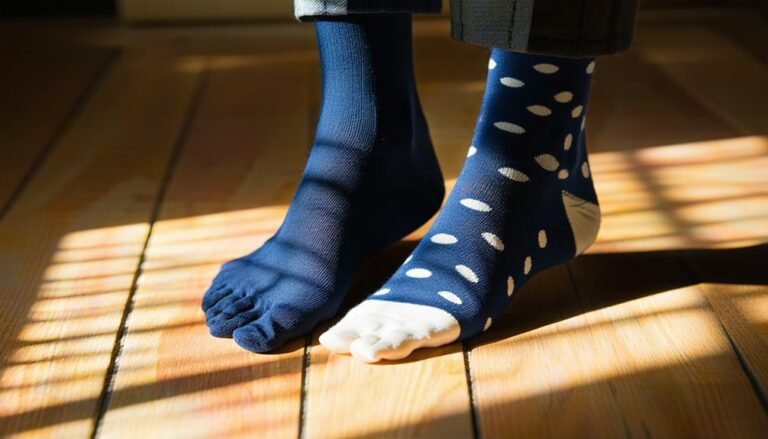Cotton Socks Vs Wool Socks
Choosing between cotton and wool socks impacts foot health and comfort due to their distinct material properties. Cotton offers breathability and moisture absorption but retains dampness, which might cause discomfort. Wool, with its natural insulation, wicks away moisture effectively, keeping feet dry and odor-free even when damp. Wool's durability surpasses cotton, lasting longer under stress. Understanding these differences can help you select the right socks for varying conditions, enhancing the foot comfort in different environments.
Understanding Cotton Socks
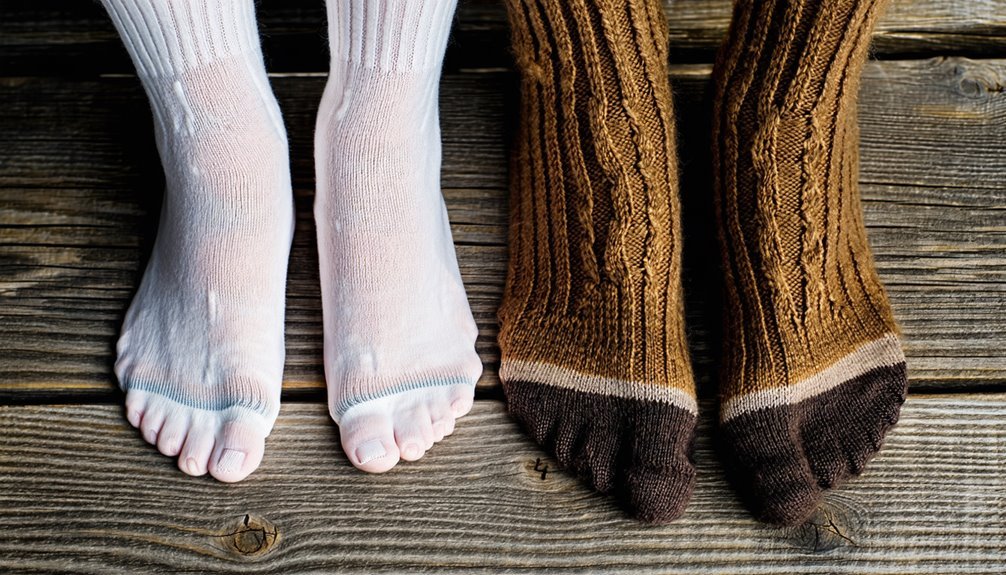
When delving into the composition and characteristics of cotton socks, you'll find that their primary allure lies in cotton's innate breathability and moisture absorption properties. This natural fiber effectively wicks moisture away from your skin, enhancing comfort and reducing the risk of fungal infections, a significant cotton benefit. Furthermore, cotton's hypoallergenic nature guarantees that sensitive skin remains safe from irritation.
However, cotton drawbacks must be considered. Cotton socks, while breathable, tend to retain moisture once saturated, potentially leading to discomfort and increased friction. This retention can decrease thermal regulation, making them less suitable for cold or excessively wet conditions. Understanding these material properties allows you to make informed decisions, prioritizing your safety and comfort in various environments by choosing the most appropriate sock material.
Exploring Wool Socks
When considering wool socks, you'll appreciate their natural insulation properties, which regulate temperature by trapping air within the fiber's crimped structure. Their moisture-wicking capabilities stem from wool's ability to absorb up to 30% of its weight in water without feeling damp, ensuring your feet remain dry and comfortable. Additionally, wool's inherent durability and resilience result in socks that maintain their structural integrity over extended periods, offering both longevity and cost-effectiveness.
Natural Insulation Properties
While examining the natural insulation properties of wool socks, one discovers their exceptional ability to regulate temperature due to the unique structure of wool fibers. Wool fibers possess a crimped, interlocking pattern, creating air pockets that enhance thermal insulation. This natural insulation guarantees that your feet stay warm in cold environments and cool in warmer conditions, offering a versatile thermal barrier.
When conducting a fiber comparison, wool stands out due to its inherent safety features. Its flame resistance adds an extra layer of protection, vital for safety-conscious individuals. Additionally, wool's resilience to compression maintains its insulating properties over time, unlike other materials that lose effectiveness. By choosing wool socks, you prioritize foot safety and comfort without compromising on the material's thermal efficiency.
Moisture-Wicking Capabilities
Exploring the moisture-wicking capabilities of wool socks reveals their exceptional performance in maintaining dry and comfortable feet. Wool's natural fibers demonstrate superior sweat absorption, drawing moisture away from your skin into the core of the fiber. This action not only keeps you dry but also prevents the formation of blisters, a crucial safety consideration for avid hikers or anyone on their feet for extended periods.
When conducting a breathability comparison, wool excels due to its unique fiber structure, allowing air to circulate freely. This property enhances thermal regulation, ensuring your feet remain at a stable temperature. Unlike cotton, which retains moisture, wool efficiently manages perspiration, reducing the risk of fungal infections. Consequently, wool socks offer a reliable solution for moisture control and foot health.
Durability and Longevity
In addition to moisture management, wool socks stand out for their durability and longevity, making them a wise investment for those who value quality and resilience in their footwear. Wool fibers, inherently strong and elastic, contribute to superior durability factors. These fibers can withstand repeated stress without breaking, ensuring the socks maintain structural integrity over time. In a longevity comparison, wool socks often surpass other materials due to their natural resistance to wear and tear, abrasion, and pilling. Moreover, wool's inherent insulation properties offer protection against temperature extremes, enhancing safety during varied conditions. The crimped structure of wool fibers also provides cushioning, reducing friction and potential injury. Consequently, wool socks deliver enhanced performance and safety, ensuring they last considerably longer.
Comfort and Softness
When evaluating comfort and softness, the intrinsic properties of cotton and wool fibers greatly influence the user experience. Cotton, with its cellulose-based structure, offers a higher softness level due to its smooth, fine fibers. This characteristic guarantees a gentle skin contact, minimizing irritation risks. In contrast, wool fibers possess a crimped, keratin-based structure, providing a cushiony feel. Although wool is slightly less soft than cotton, its elasticity contributes to a snug fit, enhancing overall comfort.
In a comfort comparison, cotton socks excel in soft touch, making them ideal for those with sensitive skin. However, wool socks offer a different kind of comfort, with their natural lanolin content providing moisture-wicking properties, keeping feet dry. Prioritize your specific needs for maximum comfort and safety in sock selection.
Warmth and Insulation
When evaluating warmth and insulation, you'll find that wool socks exhibit superior thermal conductivity due to their natural fiber structure, which traps air and retains heat efficiently. Additionally, wool's inherent moisture management capabilities allow it to wick away sweat, maintaining insulation even when wet. In contrast, cotton socks tend to have lower temperature regulation efficiency, as they absorb moisture and lose insulating properties, leading to potential discomfort in fluctuating conditions.
Thermal Conductivity Comparison
Though often overlooked, the thermal conductivity of socks is essential for evaluating warmth and insulation properties. Wool's lower thermal conductivity offers substantial benefits, trapping heat efficiently and providing superior insulation. Cotton, conversely, has higher thermal conductivity, which can be a drawback as it conducts heat away, diminishing warmth. This difference directly affects your comfort and safety in cold environments.
| Material | Thermal Conductivity Benefits | Thermal Conductivity Drawbacks |
|---|---|---|
| Wool | Excellent insulation | Can be too warm in mild climates |
| Cotton | Lightweight in warm conditions | Poor heat retention in cold |
Understanding these properties guarantees you make informed decisions. Wool socks are your best choice for retaining warmth, while cotton might suit milder conditions. This knowledge is significant for making sure your feet remain comfortable and safe, regardless of the weather.
Moisture Management Capabilities
Having explored thermal conductivity, let's consider moisture management capabilities, another essential factor in sock performance. When evaluating cotton socks, their primary drawback lies in limited breathability factors and sweat absorption. Cotton readily absorbs moisture, leading to prolonged wetness against the skin, which could increase the risk of blisters and discomfort. In contrast, wool socks excel in moisture management due to their superior breathability and natural sweat absorption properties. Wool fibers can wick moisture away from the skin, promoting a drier environment that enhances foot safety and comfort. Additionally, wool's ability to retain insulation properties even when damp further underscores its advantage. For those prioritizing safe, dry feet, wool's intrinsic moisture management outperforms cotton, making it the preferable choice in challenging conditions.
Temperature Regulation Efficiency
In the domain of temperature regulation efficiency, wool socks demonstrate superior performance in warmth and insulation compared to their cotton counterparts. Wool fibers possess a natural crimp, allowing them to trap air, creating an insulating layer that is essential for effective temperature control strategies. This intrinsic property makes wool an excellent candidate for maintaining stable foot temperatures in colder environments, enhancing your safety through seasonal temperature adaptation.
Conversely, cotton lacks this same insulating capability due to its straight fibers, which limit air retention and accordingly, insulation. Wool's hygroscopic nature also allows it to absorb and release moisture without compromising warmth, facilitating a more consistent thermal environment. With wool socks, you're equipped with advanced thermal management, ensuring protection and comfort in fluctuating climates.
Moisture Management
While selecting the right pair of socks, understanding moisture management is critical for comfort and performance. Wool socks excel in moisture absorption due to their natural fibers, which can retain up to 30% of their weight in moisture without feeling damp. This intrinsic property guarantees sweat is effectively wicked away, promoting sweat evaporation and keeping your feet dry. By contrast, cotton socks absorb moisture but lack efficient evaporation, potentially leading to dampness and discomfort.
For safety and hygiene, wool's breathability reduces the risk of bacterial growth, minimizing odors and skin irritation. Wool's hygroscopic nature allows it to manage moisture efficiently, making it ideal for those concerned about foot health. Hence, when prioritizing moisture management, wool socks offer superior protection and comfort.
Durability and Longevity
When considering durability and longevity, you should assess how cotton and wool socks respond to material wear and tear. Cotton fibers, being less elastic and more prone to abrasion, may degrade faster under high-friction conditions compared to wool, which has natural resilience and crimp elasticity. In varying environmental conditions, wool's intrinsic properties provide superior lifespan, maintaining integrity even in moisture-heavy or temperature-fluctuating settings, unlike cotton which may suffer from structural breakdown.
Material Wear and Tear
Although often overlooked, the durability and longevity of socks depend greatly on the material's intrinsic properties. Regarding cotton durability, it's known for its breathability but tends to wear out quicker due to its lower tensile strength. Wool, on the other hand, exhibits remarkable resilience. Its natural elasticity allows it to withstand repeated stress without losing shape. For safety-conscious individuals, understanding these properties is fundamental as they influence wear resistance and lifespan.
| Material | Key Property |
|---|---|
| Cotton | Breathability |
| Wool | Elasticity |
| Cotton | Lower tensile strength |
| Wool | High resilience |
| Wool | Shape retention |
Thus, when selecting socks for activities demanding durability, wool's resilience makes it a superior option over cotton. Choose wisely for enhanced safety and comfort.
Lifespan in Different Conditions
Understanding material properties is just the beginning; real-world conditions greatly impact sock lifespan. Cotton socks, while breathable, are highly susceptible to moisture retention, leading to accelerated degradation through microbial growth. Wool socks, conversely, exhibit superior moisture-wicking properties, enhancing longevity in damp environments. Environmental factors like humidity and temperature fluctuations considerably influence durability. In high-humidity regions, cotton's hydrophilic nature leads to quicker wear, while wool's natural lanolin offers a protective barrier, maintaining structural integrity. Additionally, exposure to UV radiation can weaken cotton fibers, reducing lifespan, whereas wool's inherent resilience provides enhanced UV protection. For safety-conscious individuals, selecting wool socks guarantees greater durability in diverse conditions, offering both thermal regulation and a prolonged socks lifespan compared to their cotton counterparts.
Ideal Situations for Cotton Socks
For scenarios demanding breathability and moisture-wicking capabilities, cotton socks excel due to their inherent material properties. Cotton's natural fibers enhance breathability, regulating foot temperature and reducing excess moisture. This is essential for maintaining foot health and preventing blisters. Cotton socks also offer a diverse color variety, allowing you to match them with different safety gear or uniforms, ensuring both functionality and personal expression.
| Scenario | Breathability Factors | Color Variety |
|---|---|---|
| Daily Wear | High | Extensive |
| Exercise | Moderate | Varied |
| Casual Outings | best | Broad |
In environments where ventilation is key, cotton's fiber structure allows air circulation, ensuring comfort and minimizing bacterial growth. This makes cotton socks a reliable choice for safety-conscious individuals in daily, exercise, or casual settings.
Best Uses for Wool Socks
Wool socks shine in specific scenarios due to their exceptional thermal insulation and moisture management properties. When considering the best activities and temperature ranges, wool socks offer unparalleled advantages. Their natural fibers provide superior warmth while wicking moisture away from the skin, guaranteeing safety in various conditions. Here are the prime uses:
- Winter Hiking: Keeps feet warm in sub-zero temperatures.
- Skiing/Snowboarding: Ideal for maintaining thermal equilibrium on the slopes.
- Mountaineering: Guarantees breathability and insulation at high altitudes.
- Cold-Weather Camping: Retains heat during long, chilly nights.
Care and Maintenance Tips
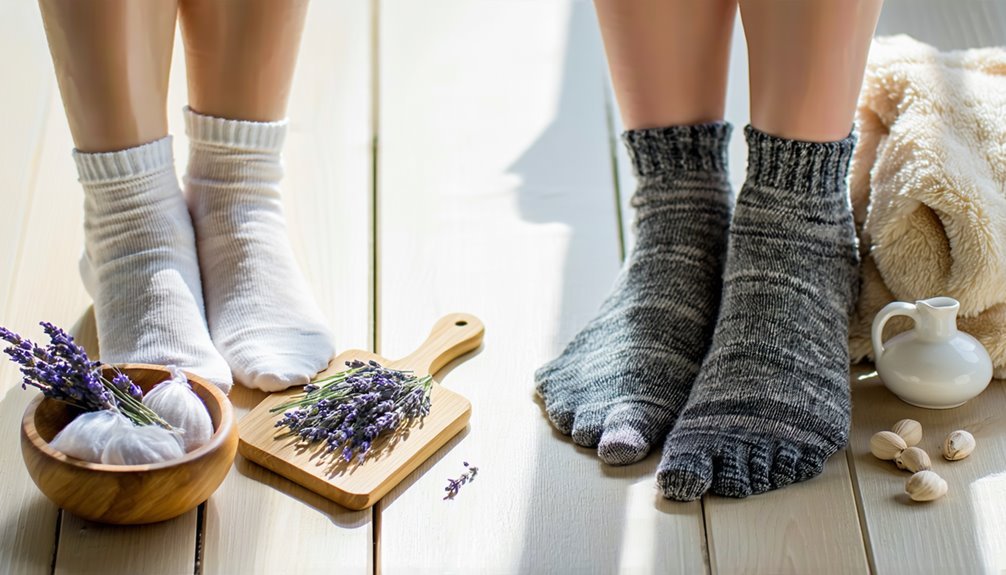
Although maintaining your wool socks might seem straightforward, employing proper care techniques can greatly extend their lifespan and preserve their functionality. Wool fibers possess unique moisture-wicking and thermal insulation properties, making precise fabric care essential. When sock washing, use a gentle, cold water cycle to prevent shrinkage and maintain fiber integrity. Avoid fabric softeners, which can impede the wool's natural breathability and moisture absorption. Instead, opt for a mild detergent specifically formulated for delicate fabrics.
Drying wool socks requires caution; air drying is preferred to reduce fiber stress and guarantee dimensional stability. Lay them flat on a clean surface, away from direct heat sources, to maintain structural integrity. By adhering to these fabric care guidelines, you'll enhance the durability and performance of your socks safely.
Making the Right Choice
Choosing between cotton and wool socks depends on understanding their distinct material properties and suitability for different conditions. Cotton socks are breathable but absorb moisture, making them less ideal for wet environments. Conversely, wool socks excel in moisture-wicking and insulation, offering superior thermal regulation. Here's how to make the right choice based on your needs:
- Weather Conditions: Opt for wool in cold, damp climates for thermal protection. Choose cotton for dry, warm conditions.
- Activity Level: Wool is better for high-intensity activities, providing moisture management. Cotton suits low-activity settings.
- Socks Fashion: Cotton offers more style variety with vibrant colors, while wool is more limited but classic.
- Safety Needs: For hypoallergenic sock materials, wool is less likely to cause irritation due to its natural fibers.
Frequently Asked Questions
Are Cotton Socks More Environmentally Friendly Than Wool Socks?
Oh, you think cotton's the eco-hero? Well, consider sustainable farming's role. Cotton's water-intensive, while wool's biodegradable and often ethically sourced. Analyze these materials' life cycles for safety: wool's natural, renewable, and a reliable choice for environmentally conscious comfort.
Do Cotton or Wool Socks Cause More Allergies?
You're concerned about allergy triggers and skin sensitivity. Wool's lanolin may provoke allergies in sensitive individuals, while cotton's fibers are generally inert. Prioritize wool socks with hypoallergenic treatments if you're prone to reactions, ensuring safety and comfort.
Which Type of Sock Is Better for Vegan Lifestyles?
For a vegan lifestyle, you'll prioritize vegan materials and ethical sourcing. Cotton, derived from plants, aligns with this. Wool, however, isn't vegan-friendly. Make certain cotton's production practices are eco-conscious and ethically sound, prioritizing safety and sustainability.
How Do Cotton and Wool Socks Impact Foot Odor?
You'd think moisture absorption would solve foot odor, yet it ironically enhances it if not managed. Cotton lacks natural odor control, while wool's keratin structure excels in moisture management, reducing bacterial growth and ensuring a safer environment.
Are There Any Fashion Trends Favoring Cotton or Wool Socks?
In current fashion trends, sock patterns and seasonal styles play an essential role. You'll notice cotton's breathability suits summer designs, while wool's thermal insulation is favored in winter. Each material's properties guarantee comfort and safety in varying climates.

